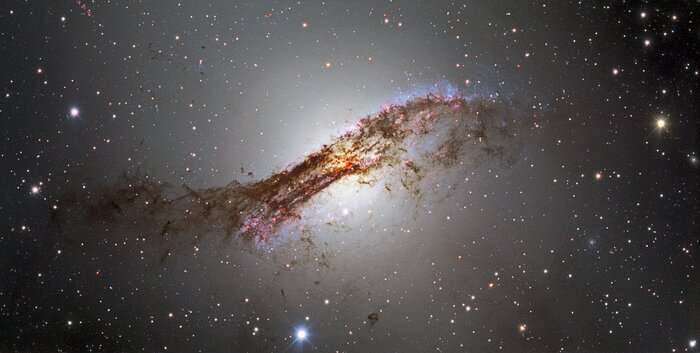A spectacular portrait of the galaxy Centaurus A has been captured by astronomers using the Dark Energy Camera mounted on the Víctor M. Blanco 4-meter Telescope at Cerro Tololo Inter-American Observatory in Chile. This galaxy's peculiar appearance—cloaked in dark tendrils of dust—stems from a past interaction with another galaxy, and its size and proximity to Earth make it one of the best-studied giant galaxies in the night sky.
The galaxy Centaurus A, which lies over 12 million light-years away in the direction of the southern-hemisphere constellation Centaurus (The Centaur), is the leading light of this striking image. This image provides a spectacular view of the luminous glow of stars and the dark tendrils of dust that hide the bright center of the galaxy. This dust is the result of a past galactic collision, in which a giant elliptical galaxy merged with a smaller spiral galaxy. As well as large amounts of gas and dust, Centaurus A's dust lane contains widespread star formation, as indicated by the red clouds of hydrogen and by the large number of faint blue stars visible at each end of the dust lane.
The proximity and brightness of Centaurus A—it is one of the closest giant galaxies to Earth—make it one of the best-studied objects in the southern hemisphere night sky. Since its discovery in 1826, scientists have studied the galaxy exhaustively with many different kinds of telescopes, revealing a variety of intriguing features. Radio telescopes reveal a colossal jet of matter spewing outward from the heart of the galaxy. This jet is accelerated to almost half the speed of light by a supermassive black hole at the center of Centaurus A, and its bright emissions at radio wavelengths make this galaxy one of the most prominent radio sources in the night sky. In fact, in July 2021, the Event Horizon Telescope produced an image of a jet launching from the black hole in Centaurus A, which weighs in at 55 million times the mass of the Sun.
Centaurus A is a reliable target for southern-hemisphere amateur astronomers, with its bright bulge and dark dust lane visible with binoculars or small telescopes. This image, however, shows a 10-megapixel subsection of the full 570-megapixel Dark Energy Camera (DECam), which is mounted on the Víctor M. Blanco 4-meter Telescope at Cerro Tololo Inter-American Observatory (CTIO) in Chile. One of the highest-performance, wide-field CCD imagers in the world, DECam was designed specifically for the Dark Energy Survey and was operated by the Department of Energy (DOE) and the National Science Foundation (NSF) between 2013 and 2019. DECam was funded by the DOE and was built and tested at DOE's Fermilab. At present the Dark Energy Camera is used for programs covering a huge range of science.
This image was obtained by astronomer Monika Soraisam (now at University of Illinois at Urbana-Champaign) as part of a long-term monitoring campaign (between 2018 and 2021) to identify variable objects on timescales from hours to years (novae, long-period variables) in prominent galaxies in the southern hemisphere. The campaign has been conducted as a pathfinder to Vera C. Rubin Observatory's Legacy Survey of Space and Time.
The analysis of data from the Dark Energy Survey is supported by DOE and the NSF, and the DECam science archive is curated by the Community Science and Data Center (CSDC) at NSF's NOIRLab. CTIO and CSDC are Programs of NOIRLab.



